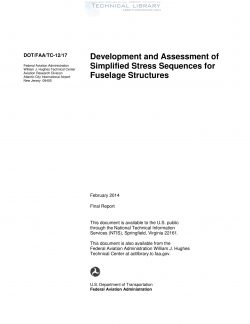DOT-FAA-TC-12-17
- Version
- 379 Downloads
- 2.73 MB File Size
- 1 File Count
- May 10, 2017 Create Date
- May 10, 2017 Last Updated
Development and Assessment of Simplified Stress Sequence for Fuselage Structures

The University of Dayton Research Institute (UDRI) investigated the feasibility of using
constant—amplitude stress sequences instead of comprehensive stress sequences to perform
assessments of crack growth located in fuselage pressure boundary structure. The goal of this
effort was to determine if complex stress sequences, which account for the major flight and
ground loads that a fuselage structure undergoes during operation, can be represented by a more
simplified one—per—flight, constant—amplitude loading. Three different sizes of transport airplanes
(a wide—body (Boeing B-777) and a narrow-body model (B-737), and a regional jet (Embraer
ERJ-l45)), which fall under Title 14 C ode of Federal Regulations (14 CFR) Part 25, were
considered.
Development of comprehensive longitudinal stress sequences at the fuselage crown
above the wing for each considered airplane model—The sequences accounted for
internal cabin pressure, steady—state inertia, and gust and maneuver incremental loading.
The sequences were developed assuming all flights were to maximum design altitude and
using published vertical load factor exceedance data for the considered airplane models.
Creation of constant-amplitude stress sequences for each airplane model with a stress
ratio equal to zero and a maximum stress due to maximum design cabin pressure and
steady-state inertia (i.e., l—g flight) plus a predetermined increment of inertial loading—
For this task, the same relations were used to determine the stress due to pressure and
inertia loads as in task 1.
Crack growth tests using the comprehensive sequences developed in task 1, the constant-
amplitude sequences developed in task 2, and comparison of the results.
Based on the data generated under task 3, it was observed that the size of the airplane had a
limited effect on the impact of the constant-amplitude sequence inertia increment that was added
to the steady-state pressure and inertia stress. Additionally, it was observed that for all three
models, a constant—amplitude, one—per—flight cycle from zero stress to a maximum stress equal to
maximum cabin pressure stress plus 1.3 times the steady-state inertia stress resulted in crack
growth that was conservative when compared to crack growth due to the comparable
comprehensive sequence.
| File | Action |
|---|---|
| DOT-FAA-TC-12-17 Development and Assessment of Simplified Stress Sequence for Fuselage Structures.pdf | Download |
Comment On This Post